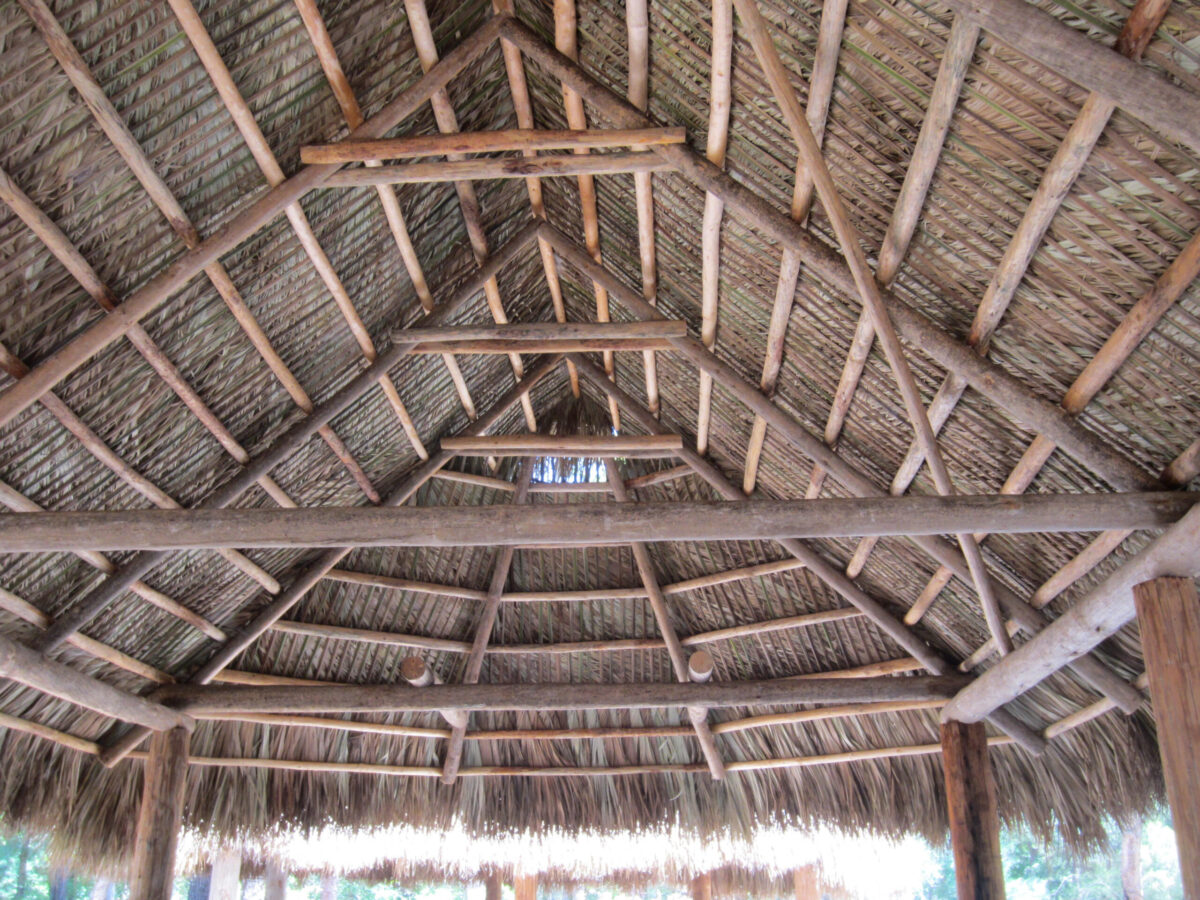
Florida Folk Festival highlights Seminole Traditions
Florida is unlike anywhere else in the world. From the Keys to the Panhandle, each part is unique and brings its own meld of culture and tradition. But, how much do you know about the many people and cultures that call Florida home? If you’re interested in a better look at Seminole traditions, check out the annual Florida Folk Festival that takes place Memorial Day weekend. Created to highlight the rich cultural diversity found in the Sunshine State, the festival features music, traditional crafting, demonstrations, and more. This week, join us to learn a little about the Florida Folk Festival, the importance of the Seminole presence at the event, and how you can attend since it starts today!
In the image below, you can see James Billie playing on stage at the 1985 Florida Folk Festival. James “Jim” Billie was the Seminole Tribe of Florida Tribal Council Chairman from 1979-2001, and then again from 2011-2016. A continuous presence at the Florida Folk Festival over the years, Billie is an accomplished musician. His song “Big Alligator” was nominated for a Grammy award in 1999. Billie also received a Living Legend Award from the Native American Music Awards that same year. Then, in 2019, Billie received a Folklife Advocate award at the Florida Folklife Heritage Awards in Tallahassee, FL. This award recognized “his resolute and effective championing of Tribal sovereignty, his decades-long commitment to preserving traditional Seminole language and culture, and his own considerable artistic achievements.” Billie also left his mark in many other ways. This includes championing the opening of the Ah-Tah-Thi-Ki Museum in 1997.
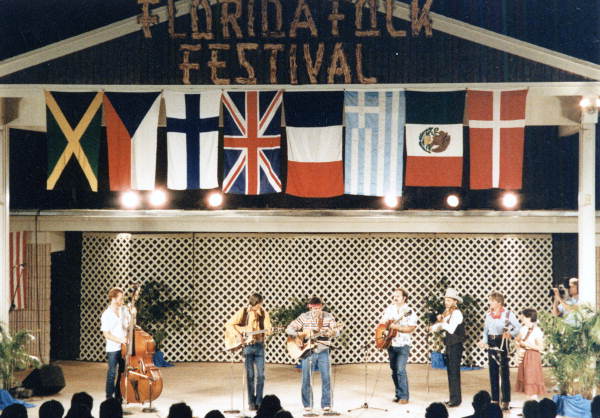
Don Grooms, James Billie, and friends performing at the 1985 Florida Folk Festival – White Springs, Florida. 1985. State Archives of Florida, Florida Memory.
Florida Folk Festival 2022
This year’s Florida Folk Festival will be from May 27 – May 29, 2022 at Stephen Foster Folk Culture Center State Park in White Springs, Florida. The Park is located on the banks of the Suwanee River, and honors composer Stephen Foster. The composer famously wrote “Old Folks at Home” in 1851, featuring the Suwanee River. It is the state song of Florida. Cabins are available to rent, as well as a full-service campground to accommodate overnight visitors. Biking, hiking, camping, horseback riding, and geocaching are also popular activities at the park. There are also numerous trails open to horses, bikes, and foot traffic. Many plants and animals also call the park home, and the Suwanee River provides a wonderful backdrop for wildlife viewing. So, keep your eyes peeled! You may spot gopher tortoises, alligator snapping turtles, cooter turtles, Gulf sturgeon, birds, and various snakes. Find a comprehensive map of the park here.
In addition to the standard amenities listed above, the park annually hosts the Florida Folk Festival. This year will mark the festival’s 70th anniversary. The three-day celebration highlights the most unique aspects of Florida culture and history that reflect “the lives of generations of Florida families and communities.” In fact, there will be over 300 performances throughout the weekend. Other demonstrations, workshops, craftspeople, storytellers, vendors, food stalls, and hands-on crafts and activities for children will be there to explore. Handicap parking and accessible restrooms are available. Additional shuttles with chairlifts will be available throughout the site. The festival gates open daily at 8 a.m., with final performances at 11 p.m. Tickets are available in advance or at the gate. Remember, this is an outdoor event. So, don’t forget your water and sunscreen!
History
The first Florida Folk Festival was held in May 1953. The idea of organizing the festival began in 1952. Ada Holding Miller, the President of the National Federation of Music Clubs, visited White Springs for a convention. After touring the Stephen Foster Memorial (now the Stephen Foster Culture Center State Park), Holding Miller suggested it was an ideal location for a folk festival. Then, Lillian Saunders of White Springs ran with the idea. After the Stephen Foster Memorial Commission approved the idea, they sought the assistance of Sarah Gertrude Knott. Knott was the founder of the National Folk Festival, and agreed to help coordinate. Then, the organizers invited community and cultural groups from across the state to participate. The first festival had a wide range of music, from gospel to jazz. It also featured storytelling, square dancing, fiddle and harmonica music, games, and Seminole music and dancing.
Over the years, the festival has become a resounding success. People and communities from all corners of the state attend and share crafts, music, dancing, food, and demonstrations. From Seminole crafters to Czech dancers, there is something to interest everyone who passes through the festival gates. In the 1969 program, Knott wrote “Little did we dream when the first two years of the Florida Folk Festival passed, with the young Festival roots in the soil of the state, that 17 years hence, the Sunshine State would have developed a real Florida Folk Festival peculiar to that state alone.” And develop it did! This year, 20,000 people are expected to attend the 70th annual festival throughout the weekend.
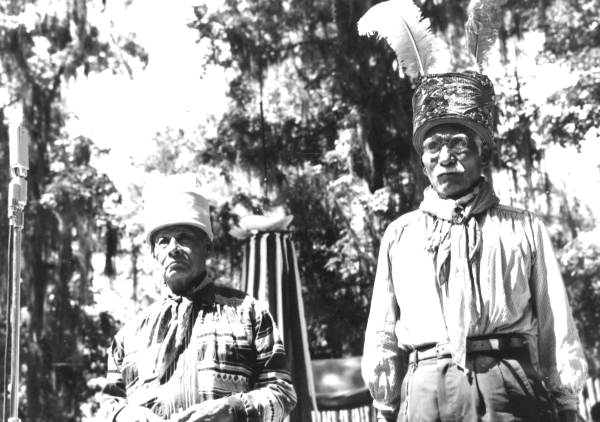
Josie Billie and Billy Bowlegs III- White Springs, Florida. 1959. State Archives of Florida, Florida Memory.
Seminoles at the Florida Folk Festival
Seminoles were present at the Florida Folk Festival since the beginning, and are listed on the 1953 program for the first festival. As the festival grew over time, so did their contributions. The festival shifted to include more traditional crafts, demonstrations, and food vendors. Consequently, the Seminoles followed suit. The Seminoles have truly been a constant part of the festival since its inception. Above is a photo of Billy Bowlegs III and Frank Shore, both Seminole elders, at the 1959 Florida Folk Festival sharing Seminole traditions. Both dressed in traditional clothing, and were a fixture at numerous festivals over the years. Bowlegs danced and sang traditional songs. Shore shared traditional knowledge about plants and herbs.

O.B. Osceola making a dugout canoe at the Florida Folk Festival,1977. State Archives of Florida, Florida Memory.
Additionally, demonstrations of Seminole traditional skills and knowledge became an integral part of the festival. Not only are the crafts themselves highlighted, but also the process. In this photo, O.B. Osceola demonstrates dugout canoe carving at the 1977 Florida Folk Festival. O.B. Osceola is the son of Cory Osceola, discussed in previous blog posts here and here. O.B. is also a skilled chickee builder, and owned a chickee business out of Naples before retiring in 2018.
Dugout canoe carving is an arduous, highly skilled process that takes time and muscle. It also takes a long time to learn. Young people learn by watching and studying an experienced carver. Pedro Zepeda, a master artisan and dugout canoe carver, attended the Florida Folk Festival and demonstrated canoe carving in the past. In a 2019 interview (3:25) with the Florida Historical Society, Zepeda outlined the importance of keeping these traditions alive. “When I’m making things, they’re not just objects. They’re carrying the knowledge and skills of all my ancestors,” Zepeda explains.
What’s under the chickee?
Attendees of the Florida Folk Festival can visit the Seminole family camp with chickees. A chickee, the Seminole word for ‘house,’ features a palmetto thatched roof over a cypress log frame. This type of architecture rose to prominence for the Seminole ancestors in the 1800s out of necessity. Seminoles needed easy to construct, disposable, and functional dwellings while evading the US troops that were under the direction of Andrew Jackson. Chickees remain a prominent fixture on the Seminole reservations and throughout South Florida still today.
James Billie, discussed above, made a career out of commercial chickee building before he became Chairman of the Seminole Tribe in 1979 and has utilized this skill throughout his life. Billie is responsible for the expansion of the Seminole Camp section of the Florida Folk Festival. Originally added in the 50s, the Camp grew with changes directed by Billie. In the featured photo of this blog post, you can see an interior shot of the Seminole Family Camp chickee expansion in 2018. The camp is representative of the traditional Seminole experience. Seminole Tribal Members offer various workshops, from crafts to cooking to demonstrations, that embody traditional knowledge and ways of life. Look below to see the crafts and demonstrations you will find at the Seminole Family Camp this year!
Seminole Crafts and Demonstrations
Patchwork, beadwork, doll making, woodcarving, and sweetgrass basket making are all Seminole traditions on display this year at the 2022 Florida Folk Festival in the Seminole Family Camp. You can learn more about the individual artisans who will be demonstrating at the festival here. These crafts rose to popularity with the first Seminole tourist camps in the early 20th century and remain important to Seminole culture and lifeways today. Learn more about patchwork, baskets, and modern basket makers in our previous blog posts!
Food
Seminole culture is closely tied with food. Traditionally, a cooking chickee in the center of the camp would be used to make food for a large family group. The fire would be tended for weeks at a time. For this reason, multiple generations would gather to eat together. Traditional foods include deer, turtle, fish, corn, swamp cabbage, beans, squash, sofkee, and fry bread. Sofkee is a warm stewed porridge drink made of corn or rice often flavored with fruit, pumpkin, or other spices. Fry bread is another popular recipe, and can be sweet or savory. To learn more about traditional Seminole foods, you can check out a previous blog post here. In addition, Mollie Jolly and Jennifer Billie will demonstrate Seminole cooking traditions in the Camp.
So, whether you are coming for music, food, history, or culture, there is something for everyone at this year’s Florida Folk Festival. Enjoy one of the many outdoor music performances, and stop by the Seminole Family Camp for sofkee and frybread. Experience demonstrations, and learn more about Seminole traditions and ways of life. Where old Florida traditions meld with modern Florida, the Florida Folk Festival is a great family-friendly learning experience.


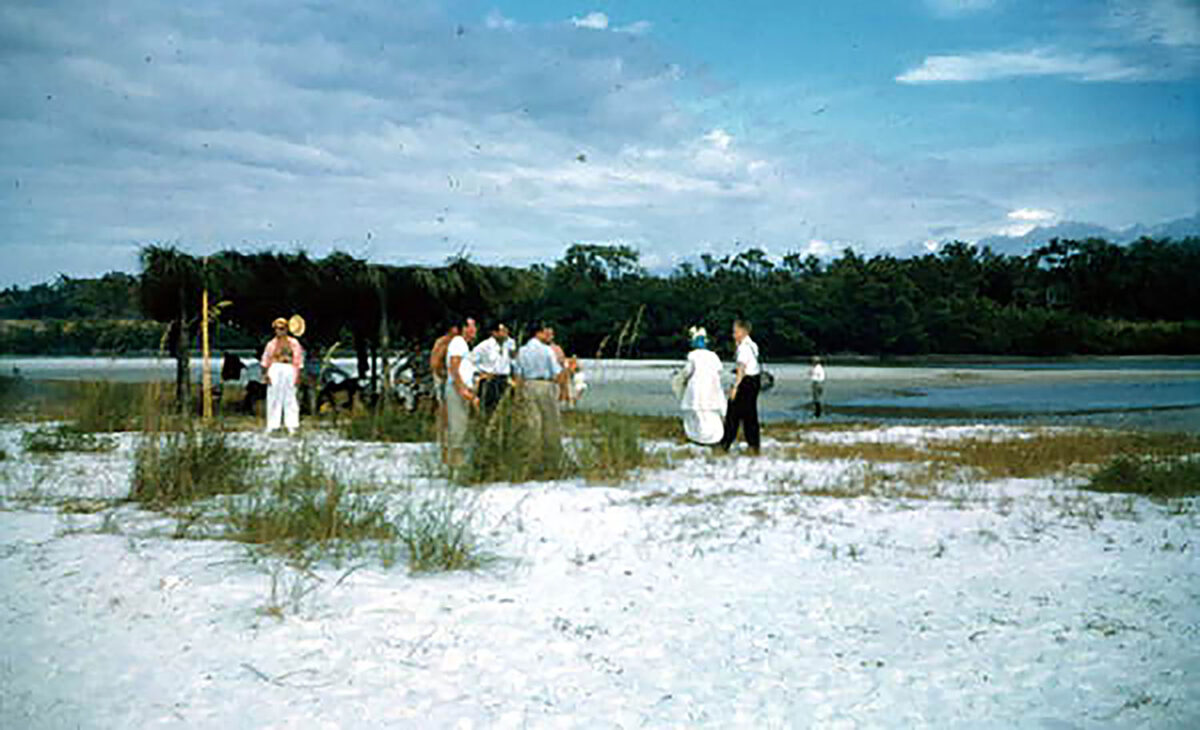
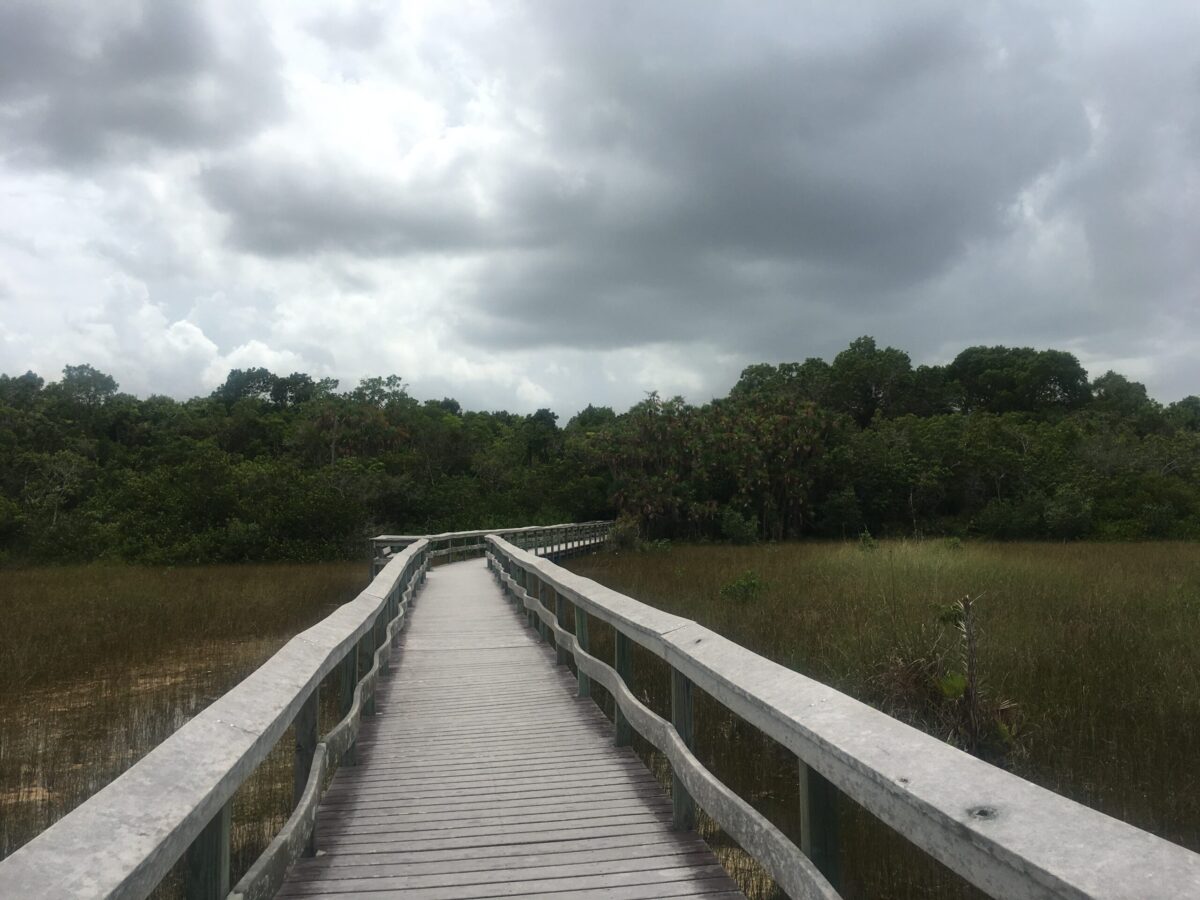
Pingback: Summer Reading Book Club - Florida Seminole Tourism